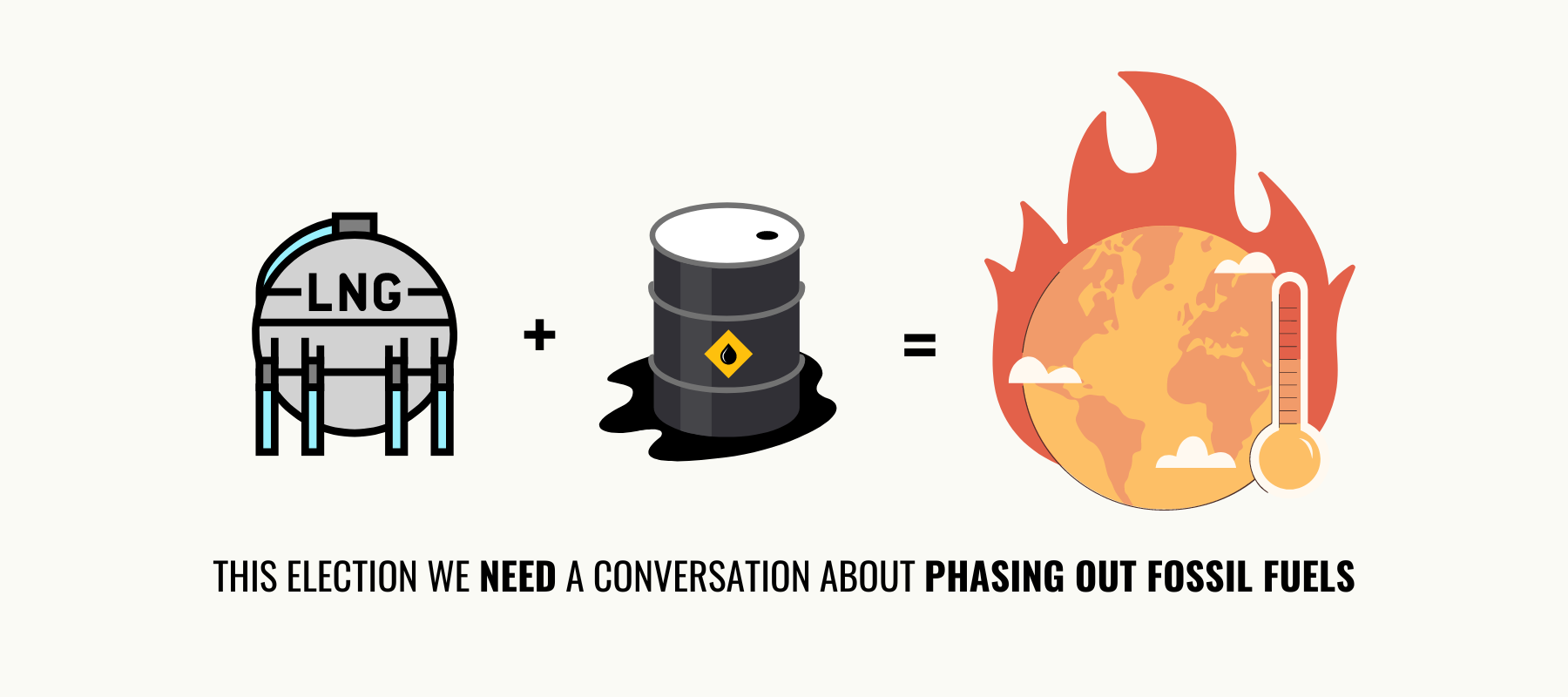This election we need a conversation about phasing out fossil fuels

BC’s forests were burning again this summer, in what’s become a gruesome annual reminder of our collective inaction on reducing the greenhouse gas (GHG) emissions changing our climate.
While some argue that BC is too small to have any impact, addressing climate change is a global collective action problem. Jurisdictions like BC—wealthy in skills, capital and resources—need to be leaders.
In this BC election, we need to have a real conversation about upping our climate game. That means phasing out the production and consumption of the fossil fuels that are causing climate change.
Fossil Fuels vs Clean BC
BC has been ahead of other provinces on the climate file, and with tri-partisan support. The 2008 Climate Action Plan, brought in by the BC Liberals, included Canada’s first carbon tax, legislated GHG emission reduction targets and a range of climate-related expenditures.
The NDP government’s 2018 CleanBC plan (backed by the Green Party) set BC’s current GHG emissions target of a 40% reduction below 2007 levels by 2030. The plan committed to further annual carbon tax increases and launched new programs aimed at buildings, transportation and industry, including pilot programs and research initiatives.
In spite of these new climate policies, accompanied by federal climate actions in response to the 2015 Paris Agreement, the fossil fuel industry has been successful at ragging the puck and protecting its core business interests in BC.
Consider the following two charts, which look at domestic consumption of fossil fuels. The first shows that in 2022 the amount of gasoline sold in BC was not much different than in 2007, the year BC first legislated GHG reduction targets. Diesel sales have grown in recent years, reflecting booming freight transportation, and hit a record high in 2022.
To be fair, BC’s population and economy have also grown. This means most of the new growth has been accommodated by cleaner vehicles and fuels. But the core point remains: the companies selling motor fuels have been able to protect their markets from shrinkage (although their sales would probably be higher in the absence of BC’s climate policies).
The second figure shows BC’s natural gas consumption was about the same in 2023 as in 2007. After a period of decline after 2007, gas consumption in homes, commercial buildings and industry has grown in recent years. As with vehicles, the core business model of gas companies has held up through two major waves of government-led climate action.
The conclusion is inescapable: the wide range of climate policies introduced in BC—a December 2023 CleanBC report lists 92 actions—have failed to shrink the province’s fossil fuel consumption. As a result, BC is on a pathway to badly miss its 2030 GHG emission reduction target.
Emissions and Exports
Things get worse when we add in the production of fossil fuels for export. A previous post looked at BC’s Energy Action Framework, which reflects an ongoing push for LNG exports with major implications for BC Hydro’s electricity supplies. This conflicted approach to climate and energy policy is evident in the newly-approved Cedar LNG project.
Emissions from exported fuels get counted where they are combusted but even the domestic emissions associated with extraction and processing (that do count in BC’s GHG inventory) undermine BC’s ability to meet its targets. For example, the 2025 opening of LNG Canada will add about 4.3 million tonnes (Mt) of carbon dioxide to BC’s 64 Mt emissions inventory. This is from the Kitimat terminal only and does not count additional emissions from fracking in BC’s Northeast.
Locked-in emissions from LNG Canada will also make it extremely difficult for BC to meet its longer-term 2040 (60% below 2007) and 2050 (80% reduction with a promise to be net-zero) emission reduction targets. A possible Phase 2 of LNG Canada would make this problem even worse, as will plans for Woodfibre LNG near Squamish and Cedar LNG up the coast.
Revisiting Carbon Pricing
If anything, climate action needs to be scaled up, not rolled back. The BC Conservatives, however, question the urgency of the climate crisis and would scrap fuel and carbon taxes along with the CleanBC program aimed at reducing BC’s domestic emissions.
The NDP for their part would also do away with consumer carbon pricing, having already knee-capped carbon pricing for industry by exempting a large share of their emissions while providing loopholes like carbon offsets for the remainder.
In both cases, the federal government’s carbon price backstop would kick in should BC unilaterally revoke its carbon tax. A change in federal policy, however, is not out of the question before or after the next federal election.
Walking back carbon pricing is a mistake. BC’s carbon tax makes it more expensive to pollute (currently 18 cents per litre at the pump) and raises revenue that can be used to reinforce climate action through new investments in decarbonization (expansion of public transit, electric charging stations, building retrofits) and to compensate low-to middle-income households.
BC’s carbon tax is now a substantial revenue source, estimated at $2.6 billion in 2024/2025. An estimated $1 billion of that goes to the Climate Action Tax Credit (CATC), which is paid out quarterly and has become an important income transfer to low-income households (current maximum CATC of $504 for an adult, $252 for a spouse or common-law partner and $126 per child).
BC’s carbon tax is set to rise annually by $15 per tonne (about 3 cents per litre at the pump) and is currently scheduled to reach $170 per tonne by 2030 (or 37 cents per litre at the pump), all reflecting the federal government’s schedule for minimum carbon prices.
By continuing to boost the CATC, while using remaining revenues for new investments in clean energy, public transit and other zero-carbon infrastructure, the BC carbon tax can continue to be a fiscal engine powering the energy transition.
Looking for a Managed Wind-down
It’s not too hard to envision zero-carbon buildings and transportation. The energy transition is already happening in the form of electric and hybrid cars and buses on the roads and in passive-house and net-zero buildings.
More fundamentally, we need to transform cities away from car dependency with a greater emphasis on public transit, walking and biking, which also means more increased density and abundant housing in more complete communities.
There is progress on the horizon. New buildings will need to achieve net zero emissions as of 2030 via a new Zero Carbon Step Code. Older homes and commercial buildings need retrofits to improve energy efficiency (insulation, windows, exterior walls) and to switch off of fossil fuels.
This can include solar panels on rooftops, but the key technology for buildings is the heat pump, which is already used in many parts of the world. Because most household energy consumption is for space and water heating, heat pumps also mean more efficient (read cheaper) heating in winter for homes already using electricity. And with heat waves a growing concern in summer, heat pumps also provide cooling.
The BC government recently expanded its subsidy program for heat pumps with help from the federal government ($150 and $100 million respectively). As of 2021, less than 4% of BC homes used a heat pump so there is a large gap to close.
In transportation, the BC government has signalled change with zero-emission vehicle sales targets of 26% of new light-duty vehicles by 2026, 90% by 2030 and 100% by 2035. However, action outside of light-duty vehicles, including trucks and freight transportation, is still needed.
Up to 2022/23, BC provided incentives for about 110,000 light-duty low- and zero-emission vehicles, plus some additional measures for commercial vehicles, school buses and charging stations. Subsidies for zero-emission vehicles are now income-tested, with rebates up to $4,000 for vehicles under $55,000 in price (combined with a $5,000 federal rebate for $9,000 total).
However, there were 3.6 million vehicles registered in BC in 2022, a number up by almost 347,000 since 2017. Even if all private vehicles were switched to zero-emission ones, this would do nothing to address congestion delays and other costs of car dependence in BC.
Public transit must therefore play a much bigger role in reducing congestion and improving goods movement, in addition to GHG reductions. The BC government has rightly implemented new transit-oriented development zoning toward more dense housing in the vicinity of transit hubs, but missing in action have been commensurate commitments to boost transit capacity.
Our Connecting BC report outlined a ten-year investment strategy to triple the number of buses on the roads, implement an inter-community express bus service and invest in new rail and ferry connections, all in an integrated fashion. To get there we recommend that the BC government step up on providing more operating funding for transit in order to boost system growth, reliability and frequency of services.
The BC and federal governments are providing funding to BC Transit to shift to electric buses by 2040. However, a more aggressive plan to expand and invest in public transit is needed to connect BC and provide reliable high-quality alternatives to personal vehicles.
Finally, GHG reductions for large industry also remain elusive. The key sector is the production of fossil fuels, which accounts for one quarter of BC’s emissions. Planning for the growth of LNG in particular will increase BC’s GHG emissions and will compete for BC Hydro electricity that is needed for the energy transition in homes, vehicles and businesses.
Phasing out fossil fuels through a managed wind-down is thus key to achieving our emissions targets.
For all of the talk of climate action and leadership—now going back 17 years—very little has actually occurred in BC to move the needle on phasing out fossil fuel consumption or production. With both major political parties seeking to end BC’s carbon tax, neither has stated alternative policies that will get the province on track to meet its GHG reduction targets.
Topics: Climate change & energy policy


